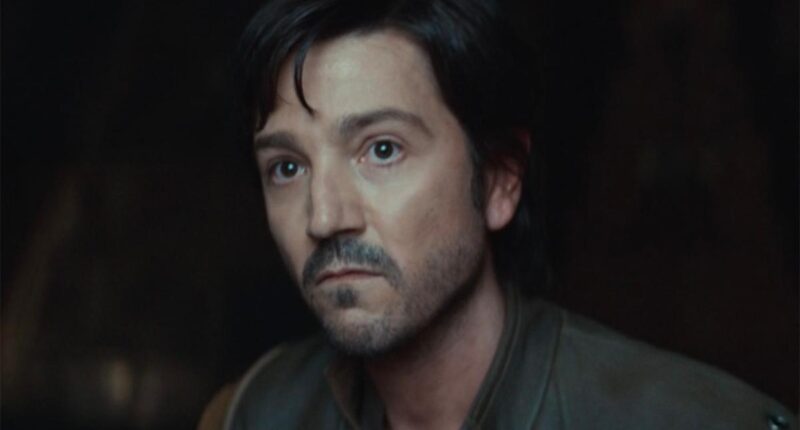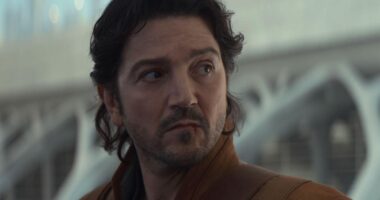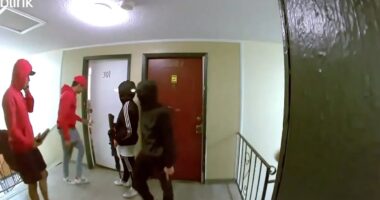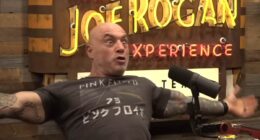Struggling may feel overwhelming at times, facing uncertainty and seemingly insurmountable obstacles. However, the concept of freedom is innate and emerges effortlessly. Acts of rebellion happen sporadically across the galaxy, with individuals unknowingly joining the cause. The Rebellion’s influence is limitless, and every small act of defiance moves its boundaries forward. It is essential to remember that the Empire’s need for control stems from its artificial nature. Authoritarian rule is fragile and demands constant vigilance. Fear is the foundation of oppression.
A fallen man’s message to another echoes through time. Known as Nemik’s manifesto, “The Trail of Political Consciousness,” these words resonated with Cassian Andor before his mother’s funeral. At that moment, Cassian transitioned from a mere thief with a personal vendetta against the Empire to someone who grasped the need to comprehend and challenge the enemy, envisioning a better future to strive for.
Nemik’s manifesto has permeated various spheres, notably reaching the ears of Major Partagaz within ISB headquarters in the final episode of “Andor.” The manifesto’s dissemination has instilled fear and bewilderment among many, including Partagaz, prompting him to ponder the unknown origins of the provocative messages that have captivated the masses.
Lagret has come to summon him to a disciplinary meeting, but both men know Partagaz has no intention of going. He’ll be dead at his own hand within a couple of minutes. Partagaz kills himself rather than face the music for his failure to capture Luthen Rael’s assistant Kleya and safeguard the security of the plan’s for the Emperor’s super-weapon, the Death Star. Like many fascists when they realize their cause is hopeless, he takes the easy way out.

Dedra Meero is not so lucky. In the montage that closes the episode, we see her in clothing that’s instantly recognizable from the part it played in arguably the series’ high point, out of many: the prison arc, in which Cassian Andor discovers the Empire has effectively enslaved every criminal in the galaxy for life in order to manufacture parts that prove to comprise the Death Star itself. Now Dedra is in such a prison, and we know from Cassian’s experience that for a person like Dedra, there is no way out.
The montage reveals the final(ish) fates of all the major surviving players. Wilmon and his girlfriend Dreena live happily together at the Rebel base on Yavin. So do Mon Mothma (with a new close-cropped hairstyle) and her cousin Vel, who we last see eating in the outdoor mess with all the other grunts. Mon’s jilted husband Perrin is back on Coruscant, living the high life with Runia Sculdon (Rosalind Halsed), the glamorous wife of his son-in-law’s oligarch father, which seems complicated. The Force healer who made such an impression on Cassian and Bix is hard at work unloading cargo, though she and Cassian share a head nod that communicates his acceptance of, if not her prophecy that he’s a messenger of fate, then at least her believe that he has an important part to play.

Far away, on the hallowed planet of Jedha, rogue Rebel extremist Saw Gerrera plots for his final stand. Far above scenic Scarif, Director Orson Krennic supervises the final stages of the construction of the weapon that will be his life’s work, and his life’s end.
The most impactful of all these final glimpses is that of Kleya Marki. Actor Elizabeth Dulau has essentially been asked to carry this final three-episode chapter on her back, after portraying a role that is by definition that of a supporting player. It’s incredible that her finely calibrated work with Stellan Skarsgård as Luthen over the course of Andor’s two seasons, plus a few flashbacks, plus what she’s done this final week are enough to sell her as a lynchpin figure in the show’s moral-emotional calculus, but here we are.
Kleya’s problem at first is physical, the wounds she incurred during her frantic flight from Coruscant while defended by Cassian and his brothers-in-arms Melshi and K-2SO, but that’s the least of it. She didn’t want to come in the first place. She didn’t want to go someplace her savior, mentor, and father, Luthen, would not be welcome or wanted. But she clearly also didn’t think she deserved safety, or peace, or fellowship, or companionship, or society. Living in the shadows, constantly hunted, knowing that the life and death of a galaxy hinges on your decisions…ask Frodo Baggins how easy that is to come back from. But in a beautiful grace note, as she watches the Rebels haul equipment to actually build things, to build the Rebellion itself, she smiles, just a little. She can come in from the cold.
There are two final happy surprises, involving two of Cassian’s oldest friends. We catch up with Bix, his girlfriend, who left him to ensure he wouldn’t abandon the Rebellion that needed him. She’s living on a farm from that agricultural planet earlier in the season, where she’s been reunited with their old droid B2EMO. (I was so sad about the idea of this poor little droid never seeing his friends again after they were forced to flee that I haven’t had the heart to mention it since, but believe me, it’s been on my mind.) What’s more, she has a baby, Cassian’s baby. The show’s final shot is of Bix looking into the sky — a sky from which Cassian will never return. But the people (and droid) he loved will live on, thanks to the sacrifice that even now he’s on his way to make.
Before he goes, however, he has a conversation with one of the Rebel leaders, Senator Bail Organa. Always a Luthen skeptic, Bail is apprehensive about this big super-weapon thing, until unrelated intel comes in confirming a major part of the information Luthen and Kleya have passed along. So he pays a visit to Cassian personally to authorize a mission to follow up on the intel, because if the Empire is going to kill him, “I want to go down swinging.” “You and Luthen would have gotten along much better than you think,” Cassian replies with a mix of humor and admiration.
Then Senator Organa says something that stopped me so cold and hit me so hard I had to pause the show: “May the Force be with you, Captain.”
There’s a great and powerful beauty in giving voice to true things that are forbidden to say. This is why authoritarian governments work so hard to keep you from saying them. They will arrest you, they will disappear you, they will strongarm you, they will blackmail you, they will bribe you, they will kill you to keep you from saying them. Nemik’s manifesto points this out when it talks about how frantic tyranny’s efforts have to be to control all the spontaneous outbursts of freedom that threaten it. People want to hear true things, say true things, share true things. True things shield us from the fascists. Eventually, with effort, with sacrifice, when enough people try, true things can be shaped into a sword to kill them with.
Andor has spent two season avoiding “May the Force be with you.” It’s nearly ignored the Force entirely, except for these last handful of episode, in which its presence is minimal still. This was in large part the point of the show. Stripped of good and bad samurai wizards whose powers effectively demonstrate who’s good and who’s evil, the Star Wars galaxy was remade by showrunner Tony Gilroy and his collaborators into something, hopefully, more recognizable to us. A galaxy of slave labor in prisons. A galaxy of dehumanizing propaganda campaigns against scapegoated groups. A galaxy of arbitrary arrest, imprisonment, and execution. A galaxy of rapists and torturers and murderers in uniform, swaggering around like they own the place. A galaxy of dead friend after dead friend after dead friend, the bodies piling up all around. Andor ground its title character’s face into this dirt over and over again.
Then this man, a kind man, a good man, Obi-Wan Kenobi’s friend, Princess Leia’s dad, walks up to him and says “May the Force be with you.”
These, too, are the words of a dead man to a dead man. Bail will be killed when the Death Star destroys his home planet of Alderaan. Cassian will be dead before then, perishing in the fight to transfer the battle station’s plans to Bail’s daughter Leia. But that doesn’t matter. Forget what Cassian’s done, what he’s seen, what he’s lost, what he stands to lose. There’s good in this world. He’s a part of it. It’s a part of him. He is one with the Force, and the Force is with him.
As if to honor all this, John Williams’s magnificent Star Wars theme actually plays over the end of the closing credits, if I’m not mistaken the first time in the history of the Disney+ Star Wars TV shows that this has happened. Someone up there knows we’ve watched something special.
There are no Jedi in the world we live in, no Sith. No one will deflect a blaster bolt with a lightsaber or choke you out with a gesture. We’re not so lucky to have definitive proof of good and evil. But we can recognize it when we see it; only years, decades of conditioning can convince us otherwise. That conditioning is unnatural. Freedom is not. That’s the force we can be a part of, not a long time ago in a galaxy far, far away, but here, now.
After forty years of fandom, forty years of it being a catchphrase, “May the Force be with you” meant something to me again. It moved me. Sitting there with the television paused, I was unable to continue until I processed this feeling — the pure, simple hope for good things to happen to other people rather than bad. Rebellions, of course, are built on hope.
Hearing those words spoken aloud in this moment feels like a miracle. Four decades after it was first said on screen, “May the Force be with you” made me burst into tears. That is the power — the force, if you will — of Andor, one of the best television shows of all time.

Sean T. Collins (@theseantcollins) writes about TV for Rolling Stone, Vulture, The New York Times, and anyplace that will have him, really. He and his family live on Long Island.
(function(d, s, id) {
var js, fjs = d.getElementsByTagName(s)[0];
if (d.getElementById(id)) return;
js = d.createElement(s); js.id = id;
js.src = “//connect.facebook.net/en_US/sdk.js#xfbml=1&appId=823934954307605&version=v2.8”;
fjs.parentNode.insertBefore(js, fjs);
}(document, ‘script’, ‘facebook-jssdk’));

















